Themed collection Multimetallic complexes: synthesis and applications

Multimetallic complexes: synthesis and applications
Welcome to this themed issue of Dalton Transactions entitled: ‘Multimetallic complexes: synthesis and applications’.

Dalton Trans., 2017,46, 5472-5473
https://doi.org/10.1039/C7DT90057K
One-dimensional complexes extended by unbridged metal–metal bonds based on a HOMO–LUMO interaction at the dz2 orbital between platinum and heterometal atoms
Crystal and electronic structures of seventeen heterometallic one-dimensional chain complexes are reviewed and discussed.
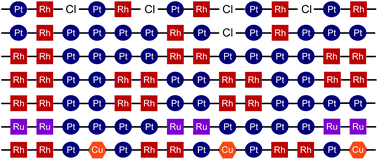
Dalton Trans., 2017,46, 5474-5492
https://doi.org/10.1039/C6DT04515D
Ethylene polymerization catalyzed by bridging Ni/Zn heterobimetallics
The effect of proximal Zn halides on Ni-catalyzed ethylene polymerization is reported in this work.
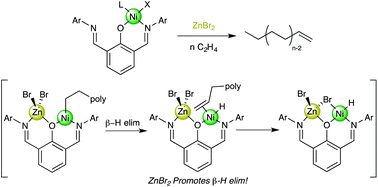
Dalton Trans., 2017,46, 5513-5517
https://doi.org/10.1039/C7DT00222J
C4-Ferrocenylsilyl-bridged and -substituted N-heterocyclic carbenes: complexation of germanium chloride
C4-Ferrocenylsilyl-bridged and -substituted N-heterocyclic carbenes and their germanium chloride complexes have been prepared and characterized.
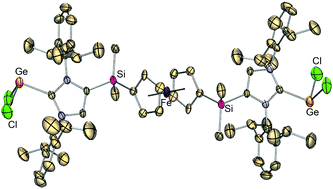
Dalton Trans., 2017,46, 5508-5512
https://doi.org/10.1039/C7DT00066A
Heterobimetallic complexes of palladium and platinum containing a redox-active W[SNS]2 metalloligand
Heterobimetallic W–Pd and W–Pt complexes have been prepared using the redox-active W(SNS)2 metalloligand.
![Graphical abstract: Heterobimetallic complexes of palladium and platinum containing a redox-active W[SNS]2 metalloligand](/en/Image/Get?imageInfo.ImageType=GA&imageInfo.ImageIdentifier.ManuscriptID=C6DT04451D&imageInfo.ImageIdentifier.Year=2017)
Dalton Trans., 2017,46, 5503-5507
https://doi.org/10.1039/C6DT04451D
Synthesis and SMM behaviour of trinuclear versus dinuclear 3d–5f uranyl(V)–cobalt(II) cation–cation complexes
Trinuclear versus dinuclear heterodimetallic UVO2+⋯Co2+ complexes were selectively assembled via a cation–cation interaction by tuning the ligand. The trimeric complex, exhibits magnetic exchange and slow relaxation providing the first example of a U–Co exchange-coupled SMM.
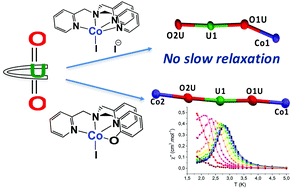
Dalton Trans., 2017,46, 5498-5502
https://doi.org/10.1039/C6DT04558H
Dinuclear oxidative addition reactions using an isostructural series of Ni2, Co2, and Fe2 complexes
Dinuclear oxidative additions at metal–metal bonds are facilitated by redox-active supporting ligands.

Dalton Trans., 2017,46, 5493-5497
https://doi.org/10.1039/C6DT04465D
Mono- and polynuclear Ag(I) complexes of N-functionalized bis(diphenylphosphino)amine DPPA-type ligands: synthesis, solid-state structures and reactivity
DPPA-type ligands (Ph2P)2N(p-Z)C6H4 (Z = H, SMe, OMe) led to Ag(I) complexes of various nuclearities and an unexpected influence of the para-substituent Z is observed, including for CH2Cl2 activation.
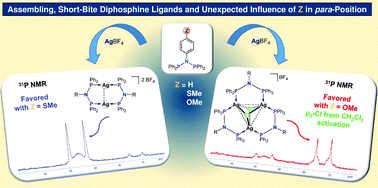
Dalton Trans., 2017,46, 5571-5586
https://doi.org/10.1039/C6DT04755F
A study of asymmetrical mixed-valent Mo2–Mo2 complexes in the class III regime
With thiolated oxalato bridging ligands, three strongly coupled, asymmetrical Mo2 dimers have been studied. In these strongly mixed-valence systems, the charge is unevenly distributed and electron transfer between the two bridged Mo2 centers occurs, as indicated by the LMCT absorption and supported by the DFT calculations.
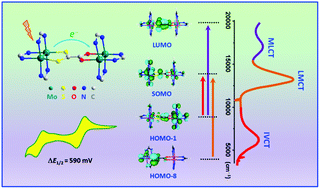
Dalton Trans., 2017,46, 5711-5723
https://doi.org/10.1039/C6DT04915J
Quasi-1D chains of dinickel lantern complexes and their magnetic properties
Four new quasi-1D Ni2 lantern chain complexes of the form [Ni2(SOCR)4(L)]∞ were prepared with N,N′-donor bridging ligands pyrazine and DABCO.
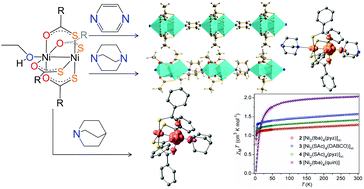
Dalton Trans., 2017,46, 5546-5557
https://doi.org/10.1039/C6DT04535A
Monodentate phosphine substitution in [Pd(κ3-dppf)(PR3)][BF4]2 (dppf = 1,1′-bis(diphenylphosphino)ferrocene) compounds
The synthesis and dissociative monodentate phosphine substitution of [Pd(κ3-dppf)(P(p-C6H4R)3)][BF4]2 compounds is presented. DFT calculations further examines the nature of the Fe–Pd interaction of the κ3-dppf ligand.
![Graphical abstract: Monodentate phosphine substitution in [Pd(κ3-dppf)(PR3)][BF4]2 (dppf = 1,1′-bis(diphenylphosphino)ferrocene) compounds](/en/Image/Get?imageInfo.ImageType=GA&imageInfo.ImageIdentifier.ManuscriptID=C6DT04921D&imageInfo.ImageIdentifier.Year=2017)
Dalton Trans., 2017,46, 5702-5710
https://doi.org/10.1039/C6DT04921D
Structure and dynamic NMR behavior of rhodium complexes supported by Lewis acidic group 13 metallatranes
Z-type complexes featuring Rh → Al and Rh → Ga interactions show distorted Rh centers and fluxionality on the NMR timescale.
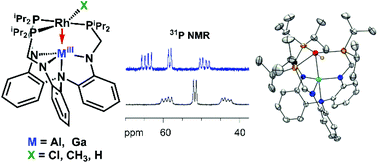
Dalton Trans., 2017,46, 5689-5701
https://doi.org/10.1039/C6DT04769F
Complexes of MN2S2·Fe(η5-C5R5)(CO) as platform for exploring cooperative heterobimetallic effects in HER electrocatalysis
Comparative study of bimetallic complexes with electronic modulations emphasizes reduction-induced hemi-lability as the key step for electrocatalytic proton reduction.
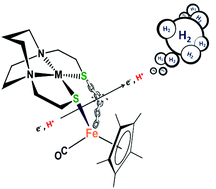
Dalton Trans., 2017,46, 5617-5624
https://doi.org/10.1039/C6DT04666E
Modulation of the CO2 fixation in dinickel azacryptands
Different linker molecules within the dinickel azacryptand moiety show strong influence towards their CO2 coordination behaviour.
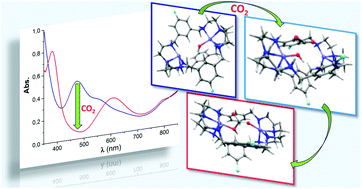
Dalton Trans., 2017,46, 5680-5688
https://doi.org/10.1039/C6DT04527H
Uranium rhodium bonding in heterometallic complexes
The UIV–RhI intermetallic distances in the U2Rh2 complex (left, 2.7601(5) Å) and URh complex (right, 2.7630(5) Å) are very short and almost identical in the solid state even though solution electrochemistry suggests very different metal-based reduction processes.
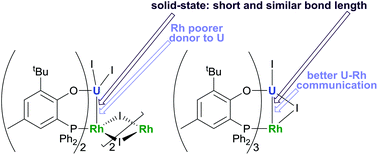
Dalton Trans., 2017,46, 5540-5545
https://doi.org/10.1039/C6DT04570G
On the coordination non-innocence of antimony in nickel(II) complexes of the tetradentate (o-(Ph2P)C6H4)3Sb ligand
The coordination non-innocence of antimony toward Cl− in ClNi(o-(Ph2P)C6H4)3SbCl results from both structural and electronic effects.
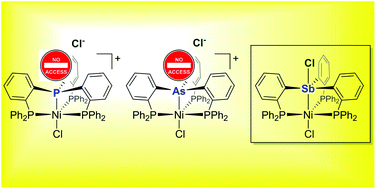
Dalton Trans., 2017,46, 5598-5604
https://doi.org/10.1039/C6DT04817J
Mixing Li and Cs in the reduction of corannulene for the assembly of a cesium-capped sandwich with a hexanuclear heterometallic core
In the first Li/Cs organometallic self-assembly, the tetrareduced corannulene decks are angled up to keep the highly-charged (Li3Cs3)6+ unit in between, with two external Cs+ ions capping the sandwich from outside.
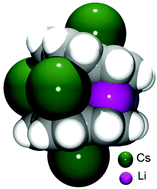
Dalton Trans., 2017,46, 5625-5630
https://doi.org/10.1039/C6DT04521A
The first examples of multiply bonded dirhenium(III,II) paramagnetic complexes containing nitrobenzoate ligands: spectroscopic, structural, cytotoxicity and computational studies
The synthesis and structural characterization of the hitherto unreported multiply bonded paramagnetic dirhenium(III,II) nitrobenzoate complexes have been reported.
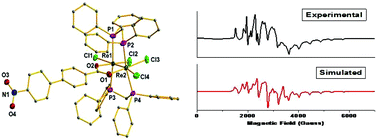
Dalton Trans., 2017,46, 5670-5679
https://doi.org/10.1039/C7DT00142H
Contrasting the group 6 metal–metal bonding in sodium dichromate(II) and sodium dimolybdate(II) polymethyl complexes: synthetic, X-ray crystallographic and theoretical studies
Adding TMEDA to [M4Cr2Me8] (M = Li, Na) causes the Li complex to go mononuclear, whereas MeNa is extruded to give [Na3Cr2Me7] and a shortening of the Cr⋯Cr separation.
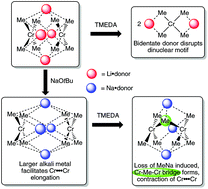
Dalton Trans., 2017,46, 5650-5659
https://doi.org/10.1039/C6DT04644D
Inter-ligand electronic coupling mediated through a dimetal bridge: dependence on metal ions and ancillary ligands
The metal–metal bond orbitals and the ancillary ligands influence inter-ligand charge transfer through the dimetal bridge.
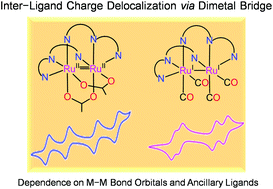
Dalton Trans., 2017,46, 5660-5669
https://doi.org/10.1039/C6DT04679G
Heterometallic molecular precursors for a lithium–iron oxide material: synthesis, solid state structure, solution and gas-phase behaviour, and thermal decomposition
Heterometallic single-source precursors with the appropriate Li : Fe ratio were shown to yield the target LiFeO2 cathode material upon thermal decomposition.
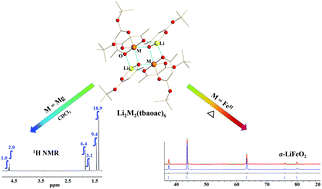
Dalton Trans., 2017,46, 5644-5649
https://doi.org/10.1039/C6DT04602A
Synthesis and characterisation of tetranuclear ruthenium polyhydrido clusters with pseudo-tetrahedral geometry
A series of tetranuclear ruthenium polyhydrido complexes with electric charges from +2 to 0 was synthesized.
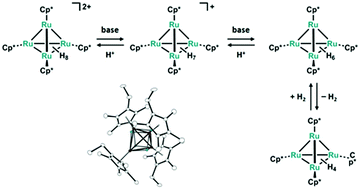
Dalton Trans., 2017,46, 5631-5643
https://doi.org/10.1039/C6DT04523E
Divergent reactivity of a new dinuclear xanthene-bridged bis(iminopyridine) di-nickel complex with alkynes
A new di-nickel complex supported by a relatively flexible xanthene-bridged bis(iminopyridine) ligand is reported and its reactivity in alkyne cycloaddition is investigated.
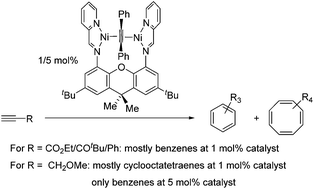
Dalton Trans., 2017,46, 5605-5616
https://doi.org/10.1039/C6DT04532D
A base-free synthetic route to anti-bimetallic lanthanide pentalene complexes
Homobimetallic complexes of Yb, Eu and Sm bridged by a silylated pentalene ligand have been prepared and intermetallic communication studied by magnetic measurements and cyclic voltammetry.
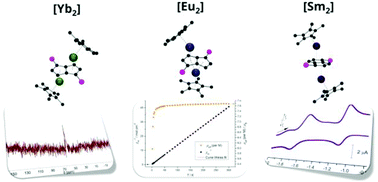
Dalton Trans., 2017,46, 5587-5597
https://doi.org/10.1039/C6DT04475A
Anilinopyridinate-supported Ru2x+ (x = 5 or 6) paddlewheel complexes with labile axial ligands
Five new metal–metal bonded Ru2 amidinate compounds with labile axial ligands are presented and discussed.
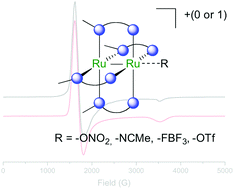
Dalton Trans., 2017,46, 5532-5539
https://doi.org/10.1039/C6DT04328C
Sandwich and half-sandwich metal complexes derived from cross-conjugated 3-methylene-penta-1,4-diynes
Mono-, di- and trimetallic derivatives of the cross-conjugated 3-methylene-penta-1,4-diyne moiety have been prepared, and studied by (spectro)electrochemical methods.
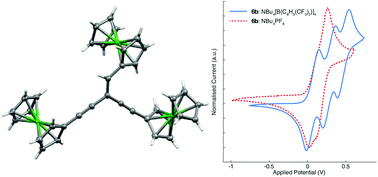
Dalton Trans., 2017,46, 5522-5531
https://doi.org/10.1039/C6DT04470K
Fundamental organometallic chemistry under bimetallic influence: driving β-hydride elimination and diverting migratory insertion at Cu and Ni
Bimetallic effects on stoichiometric β-hydride elimination and migratory insertion reactions were examined.
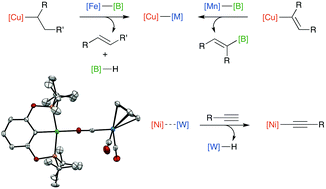
Dalton Trans., 2017,46, 5518-5521
https://doi.org/10.1039/C6DT04533B
The stepwise generation of multimetallic complexes based on a vinylbipyridine linkage and their photophysical properties
A versatile bifunctional linker provides access to multimetallic assemblies with photophysical properties, which can be exploited to detect carbon monoxide.
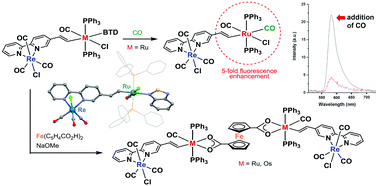
Dalton Trans., 2017,46, 5558-5570
https://doi.org/10.1039/C6DT03810G
About this collection
This issue highlights emerging trends in the synthesis and applications of multimetallic complexes, including bi- and tri-metallic assemblies as well as larger well-defined metal clusters.It covers all aspects of the study of multimetallic complexes, including their synthesis, electronic structure, magnetic and redox properties, reactivity, catalytic applications, and relevance to enzymatic processes.